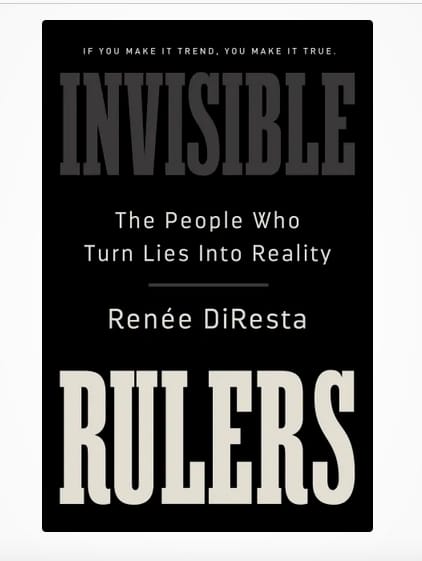Manufactured Strife

"Now, as the propaganda machine and the rumor mill have violently smashed together like two ancient galaxies, something fiery and perilous has emerged. And what has emerged is still growing, even as we struggle to accurately define it" (41). Renée DiResta
In my post of May 9, "Of Kaleidoscopes and Propaganda Machines" I touched on the manipulation of public opinion. Based on the snippet of reality that I'm tapped into, I'd say the question is not only what "public opinion" may be, but who the public truly is. We find ourselves factionalized, in a disorienting atmosphere where fact and falsehood are debated and reality denied. Many of us are trying to fathom who these people are—these fellow citizens—who favor and have even facilitated attacks on democracy, institutions, and communities. How representative of the public are the angry, aggressive voices we encounter in our social media? And are some of them even the voices of actual people?
This is an enormously pressing topic, so when I came across DiResta's book, I put it on my Learn, Imagine, Act list. The book's title references Edward Bernays' book, Propaganda. DiResta quotes Bernays' argument that "there are invisible rulers who control the destinies of millions," and his claim that "it is not generally realized to what extent the words and actions of our most influential public men are dictated by the shrewd persons operating behind the scenes." Considered the "father of public relations," Bernays long-predated the internet, writing in the 1920s.
Based on her work as a researcher at the Stanford Internet Observatory, DiResta sees our current situation as one in which:
State actors, terrorists, ideologues, grassroots activists, and even ordinary people now compete against each other in a war of all against all to shape public opinion" (41).
Within this new scene, according to DiResta, an age-old phenomenon still holds: structures of social networks can distort the perceived importance of certain views. This can create a "majority illusion," where people mistakenly think that "a minority opinion is the dominant consensus point of view overall, when it's really the viewpoint of the loudest or best-connected members of a community" (24).
The significance of the stream of voices filling our airwaves and crossing our screens can be challenging to discern in an era of bots, trolls, influencers, algorithms, and deep fakes. And although we may have heard of all those terms, we may have only a foggy idea of their impact on our everyday experience. DiResta's book sets out to help us understand the shaping mechanisms, as well as the major and minor players, currently in motion.
"Within each niche, the influencer-algorithm-crowd trinity shapes consensus and defines the beliefs of their public" (77).
In her chapter, "If You Make it Trend You Make It True," DiResta analyzes how influencers (particularly conspiracy theorists), have worked in concert with their algorithmically-attracted crowds, to spread viral rumors such as Pizzagate, Wayfair human trafficking, and QAnon theories. And the more time users spend in niche groups, discussing events and "pseudo-events," the further they can be drawn into bespoke realities, tailored to and augmenting their existing worldviews.
Explaining the influencer, algorithm, and crowd trinity and how they combine to churn out bespoke realities, DiResta takes a deep dive into the workings of platforms within the media environment. She looks at methods of "suggesting" which not only drive individuals towards specific content, but also toward groups of other users, noting that "nudging people with things they hadn't gone looking for quickly became a foundational tool for Big Tech to engage its users" (56).
When they can lead users into larger and larger webs of connection, platforms benefit from ever-increasing engagement. The numbers here are worth mulling. For example,
"Facebook's engineers estimated that typical users might have forty thousand friends of friends, while 'power users' might have as many as eight hundred thousand."
Thus, the nudges and algorithms in use on that site, and elsewhere, are working to form links "at a massive scale and in a way that transcends geography" (57).
While groups with shared interests or ideas have always gathered together, DiResta believes that "platforms have imbued crowds with new qualities" that distinguish them. These crowds are
"no longer fleeting and local but persistent and global. They engage symbiotically with influencers but don't require a leader or physical space to assemble . . . they are now active participants in chronicling history and shaping narratives" (67).
She carefully considers the role of hashtags; platform design; levels of moderation or lack of; and the directional flows and amplifications between social media and traditional media. It's a complex, emergent system.
In her chapter on "Gurus, Besties, and Propagandists", she lays out a typology of the "influencer menagerie," among them, the Explainers, Idols, Reflexive Contrarians, and the Perpetually Aggrieved. She offers examples of how they arise; stand out from the crowd while maintaining a sense of being of the crowd; gain clout; and become monetized in various ways. It's not unusual for some of these figures to have upwards of 4 million followers on just one of their multiple platforms. Brand sponsorship can be amazingly lucrative: "a big brand might pay $10,000 to a decent-sized influencer for a two-minute sponsorship pitch at the start of a video" (101). One especially large influencer raked in $350,000 for a single post. Even people writing on Substack can pull in substantial sums: "Glenn Greenwald reportedly earned around $2 million . . . each year" (108).
Unsurprisingly, stoking conflict is profitable, and the platforms know it.
"One internal report from Facebook was particularly revealing: 'Our algorithms exploit the human brain's attraction to divisiveness,' read a slide from a 2018 presentation. 'If left unchecked,' it warned, Facebook would feed users 'more and more divisive content in an effort to gain user attention and increase time on the platform'" (66).
These monetary rewards and gains in follower numbers further incentivize the posting of clickbait and ragebait. And with this comes the potential to drive crowd action in the real world, whether through merchandise sales and other marketing, or social activism and political action. The latter two areas are where things can become particularly dangerous.
DiResta tracks how "online rage" can transfer to offline behavior, leading to "threats to election officials, to public health workers during COVID, and to school board officials around curriculum debates" as well as causing "widespread resignations of targeted groups." DiResta asserts that "There is no longer any real line between online and offline . . . the virtual world's norms threaten to spill over into the real, and that can be extremely frightening"(82). Especially given how those norms are being set and by whom.
The chapter entitled "The Crowd" looks at these spillovers in more detail. She reviews situations as diverse as ISIS recruiting, GamerGate, the GameStop trading debacle, and opposing political factions' convergence around #PelosiMustGo. All of this, and we're only halfway through her book. We haven't even gotten to the parts focusing on bots and trolls, nor to her suggestions for how we might deal with this mess. I'll try to fill you in on the rest in a future post.
The book came out in June of 2024. As we think about the many disruptive and often-contested events we've been shaken by in the past nine months, DiResta's assertion at the end of Part I is important. Many of us realize, but may need to be reminded that:
What you see in your online crowd or in your bespoke reality is often wholly different from what is rippling through others'. There is consensus and cohesion within the crowds but often not across them. Every crowd proclaims itself the public, while it is merely a public" (136).




